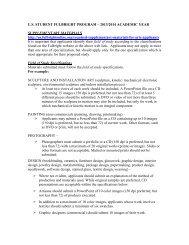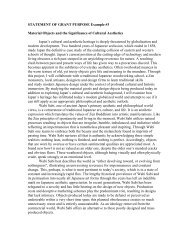PERSONAL STATEMENT Sample #2 - risd/careers
PERSONAL STATEMENT Sample #2 - risd/careers
PERSONAL STATEMENT Sample #2 - risd/careers
Create successful ePaper yourself
Turn your PDF publications into a flip-book with our unique Google optimized e-Paper software.
<strong>PERSONAL</strong> <strong>STATEMENT</strong> <strong>Sample</strong> <strong>#2</strong>Thumbing through old family photo albums, I see familiar images of mygrandmother in the same dresses and sweaters she wears today, clothes neatly maintainedfor decades. Her furniture and appliances have functioned unchanged since mygrandfather built their house in 1950. Though nothing is unkempt, everything is worn,evocative, and nostalgic. Unlike an antique showroom, her home is a lively space:diffused lamps, bookshelves containing thirty-year old encyclopedias rendered useless bythe Internet, a mottled coffee pot. The rooms are free of clutter, apart from the occasionalpicture frame and small ceramic figurines occupying end tables. My grandmotherunknowingly, or perhaps due to financial reasons, resisted defining herself, her livingspaces, and her life through the lens of style, trend, and accumulation of material goods.She at once carved a pleasant existence for her and her family intrinsically rooted in theappreciation of what is basic and essential.My grandmother is ninety-seven years old. She was born in a tiny village in themountains of Sicily, a month after the sinking of the Titanic. Due to difficult conditionsthere, she immigrated to the United States at the age of nineteen, living for a time in afour room apartment with her family of seven; she never had the opportunity to get aneducation and is mostly illiterate. Her husband, my grandfather, passed away in 1957when my father was three. My grandmother spent twenty years of her life working oversixty hours a week, while raising two children. Inured to a stoic life of hard work andprivation, she rarely buys new things. Still, she is content.Growing up in American society, I have become aware of the desire and pressureto accumulate. Materialism of the moment has the potential to dominate a person as wellas a society, particularly in the United States where Americans consume 24% of theworld's energy, yet constitute only 5% of the world's population. I look to the simplenature of my grandmother with envy. Why do I need so much to be content? I readilyadmit that I live a very fortunate and sheltered life, free, for the most part, of the tragediesand hardships my grandmother faced. Perhaps without these I can never truly realize theessence of her humble existence. I look to the Japanese world view of Wabi Sabi toprovide a means of understanding this modest way of life. While Wabi Sabi isquintessentially Japanese, its values are inherently universal. These values are exhibitedin bold quietude by my grandmother.Two years ago while pursuing my education at Rhode Island School of Design, Itraveled to Japan as part of a study abroad project through the Ceramic Department.During this month, in tandem with ceramic studies, I worked on an independent studyproject focused on Japan’s cultural and philosophical identity. With the guidance ofYuriko Saito, RISD Philosophy Professor and published scholar in the fields ofEnvironmental Studies and Japanese Aesthetics, I formulated a project that incorporatedmy scholarly interest in traditional Japanese culture as well as an in-depth hands-on studyof Japanese material goods, particularly Japanese pottery. As I soon discovered, theseinterrelated areas complemented each other in ways I did not ever expect. My experiencein making traditional material objects in a culturally sensitive way, in conjunction withmy study of Wabi Sabi principles, allowed me to holistically observe present dayJapanese culture. It became clear to me that Wabi Sabi is ideal to a world in urgent need
of a sustainable revolution, as our time living and consuming as we do now, seems evermore fleeting.Working this past summer with Uhuru Design, an environmentally friendlyfurniture design company based in New York, I became skilled at designing andfabricating sustainable products for mass production. These products, objects that striveto be timeless, practical, and innovative, inspire me. In contrast, I looked at theimmensity of products sold today; ones that adhere to market trends and lookincreasingly dated as seasons pass are discarded prematurely. These short-lived relics aremeant to lose value with age, are poor metaphors for living, and increase superfluousconsumption in our market driven society. This is fundamentally destructive and creates asurplus of unnecessary waste.Design has the potential to rouse and cultivate fresh ways of interacting with theworld. As a designer, I hope to make a positive contribution to not only the field ofdesign, but also to the way people live their lives. My intentions are transcendent ofarbitrary aesthetic decisions, which seem to be the paramount attribute of many massproduced objects manufactured today. I hope to articulate the Wabi Sabi world view;integrating sustainability with the power of relevant and poignant aesthetics. I believethere exists in everyone a yearning for something deeper than the fastest cars, latestclothing, and flashiest cell phones. What if we could learn to be content with our lives,just as they are now? It is a lofty idea, but one that I find worthy of entertaining.
















